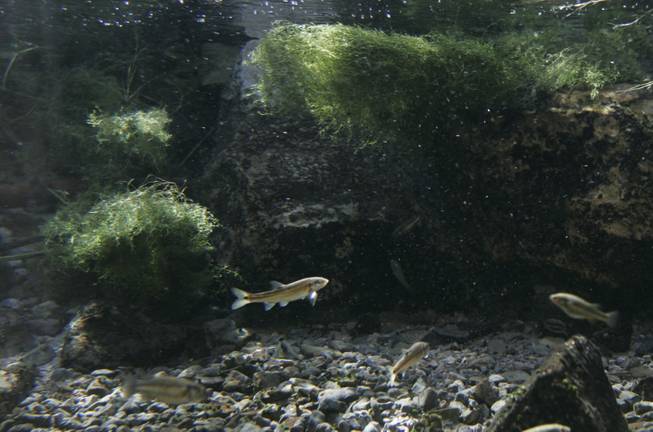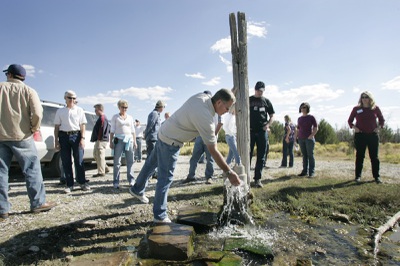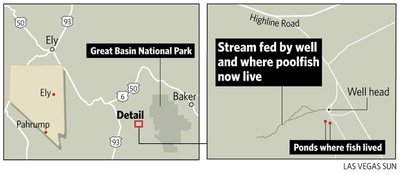
Dace, which share ponds in Spring Valley with the Pahrump poolfish, are seen through glass at the Warm Springs Natural Area.
Tuesday, Nov. 18, 2008 | 2 a.m.
Enlargeable graphic
Sun Topics
Sun Archives
- Warnings made over rural water (7-7-2006)
- Report: Wildlife refuge among most endangered (10-8-2004)
One of the few places in the world the endangered Pahrump poolfish calls home is a stream that’s not supposed to exist — hundreds of miles from Pahrump.
The stream gushes from a pipe that’s been pouring Great Basin aquifer water onto the high desert of Spring Valley since the Roosevelt administration. The Civilian Conservation Corps drilled the well to fill a swimming pool used by the workers’ camp.
Almost 70 years later — with the pool long gone, water in short supply and the Southern Nevada Water Authority wanting to dip its own straw into the aquifer for Las Vegas — it might seem logical to cap the gushing well, to stop the waste.
But it’s too late for that. Turning off the spigot would kill the inch-and-a-half-long pool-
fish, not to mention drying up the grassy meadow the stream has created, now a favorite of migrating water birds, big game and the sensitive northern leopard frog.
“It may seem like a waste, but there is some value to that water going out into the meadow,” says Zane Marshall, an environmental biologist with the water authority.
It’s on Bureau of Land Management property, and the BLM designated the meadow and nearby ponds as critical habitat this year.
The BLM and wildlife agencies have been studying the area since the 1980s.
And it has taken about a year for employees of four agencies — federal, state and local — to agree on a water-saving solution that works for the poolfish and other animals. Though that solution won’t mean turning off the tap altogether, it will mean much less Great Basin aquifer water spilling onto the valley floor.
To fully appreciate why this has been such a conundrum, though, one needs to know the history of the poolfish.
It would be only natural to assume that the Pahrump poolfish actually lives in Pahrump. And once upon a time it did. But its home in Manse Springs, about 220 miles away from the Spring Valley stream as the crow flies, dried up in 1975. Before the last drops were drained to irrigate fields nearby in the early ’70s, state and federal wildlife employees moved as many of the poolfish as they could save to three sanctuaries — at Spring Mountain Ranch near Red Rock Canyon, at Corn Creek on the Desert National Wildlife Range and at Shoshone Ponds near Ely and the gushing wellhead.
Today there are about 2,070 poolfish at Spring Mountain, about 60 at Corn Creek and 2,500 in Shoshone Ponds, according to Bob Williams, who heads up the Fish and Wildlife Service’s Nevada office.
But although the poolfish is stable today, that wasn’t always the case.
The Pahrump poolfish was an endangered species before the Endangered Species Act even existed, having been designated under a predecessor law in 1968.
The three Shoshone ponds were dug specifically to house the poolfish and another fish species, the relict dace. The ponds are fed by a different well, and after vandals turned off the water source in 1974 the Shoshone poolfish died. More of their kin were placed in two of the ponds using stock from Corn Creek two years later, and there they’ve lived ever since.
Or so scientists thought.
Turns out the wily fish has migrated, not only into a nearby pond used to water cattle, but also into the foot-wide, six-inch-deep stream that stretches 200 or 300 yards from a 70-year-old pipe in the ground.
And no one seems to know how, not the Southern Nevada Water Authority, which owns grazing rights to the land where the ponds are, not the Bureau of Land Management, which oversees the area, not even the Nevada Wildlife Department or the federal Fish and Wildlife Service, which put the fish in the ponds in the first place.
Still, a few dozen fish are holding hostage enough water to serve two or three dozen Las Vegas households.
So when the BLM applied for water rights, state officials asked the BLM to start controlling how much water the birds and fish there are actually getting. Rather than allowing the well to flow at whatever rate it pleases, the BLM will install a valve that will water the desert with no more than 7.57 acre-feet — nearly 2.5 million gallons — every year.
Instead of splashing directly onto the valley floor, the water will once again fill the old swimming pool. Once the pool is full it will overflow into the meadow. The BLM has until May 31 to install the valve and complete restoration of the historic pool.
Before the faucet is turned down, though, the rogue pool-
fish will be moved back into their ponds. Some will also live in the old pool.
“Part of the plan is to create another pond for the Pahrump poolfish so that we can have several ponds where the fish are, so if something happens to one pond we don’t lose that population,” said Paul Podborny, a wildlife biologist with the BLM.
And although poolfish populations are stable, Williams says the Fish and Wildlife Service doesn’t have any intention of recommending it be taken off the endangered species list.
There’s still one hurdle left: making it home again to Pahrump.



Join the Discussion:
Check this out for a full explanation of our conversion to the LiveFyre commenting system and instructions on how to sign up for an account.
Full comments policy